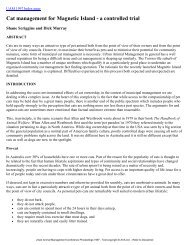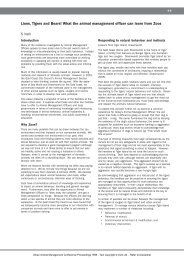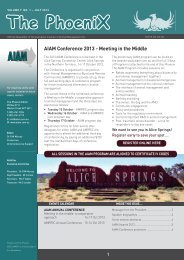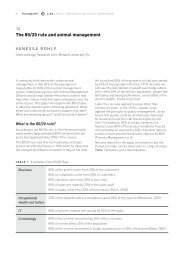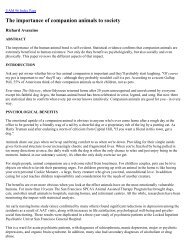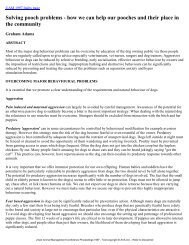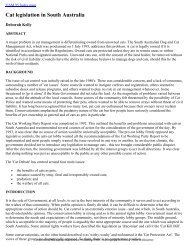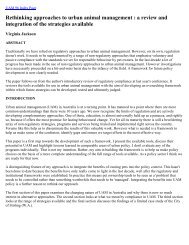Proceedings OF ThE - Australian Institute of Animal Management Inc
Proceedings OF ThE - Australian Institute of Animal Management Inc
Proceedings OF ThE - Australian Institute of Animal Management Inc
You also want an ePaper? Increase the reach of your titles
YUMPU automatically turns print PDFs into web optimized ePapers that Google loves.
42 <strong>Proceedings</strong> 2012<br />
AIAM Annual Conference on <strong>Animal</strong> <strong>Management</strong><br />
Habituation<br />
Dogs were habituated to the apparatus through a<br />
brief habituation program that involved placing a<br />
set number (n=14) <strong>of</strong> small liver treats around the<br />
apparatus for the dogs to find and consume. Dogs<br />
were then exposed to the apparatus tones. The<br />
volume was adjusted from the minimum starting<br />
point and set when the dog’s ears came forward<br />
indicating they had noticed the tone. If the dog’s<br />
ears did not come forward, the volume was set at<br />
maximum. The milk pump was then run manually<br />
until dogs licked the milk out <strong>of</strong> the milk tray without<br />
showing a response to the sound <strong>of</strong> the pump.<br />
Training phases<br />
Dogs were given at least one full session in each<br />
training phase, after which the criterion in Table 1.<br />
was implemented if it had not already been met. The<br />
only cue given in Training Phase 1 (TP1), Training<br />
Phase 2 (TP2) and Training Phase 2A (TP2A) was<br />
the tone associated with a lactose-free milk reward,<br />
henceforce, “milk tone”. The tone associated with<br />
water delivery, henceforth, “water tone”, was<br />
introduced in Training Phase 3 (TP3). Milk and water<br />
tones were played pseudo-randomly in TP3, with<br />
no more than two <strong>of</strong> the same tone being played in<br />
succession. This was in alignment with other similar<br />
cognitive bias studies in animals (Brilot et al. 2010;<br />
Doyle et al. 2010b).<br />
Cognitive Bias Test (CBT)<br />
Cognitive bias testing involved the presentation <strong>of</strong><br />
auditory probes. The latency <strong>of</strong> the dog to respond<br />
to probe tones by touching the target was logged.<br />
The probes were interspersed throughout a regular<br />
training session. No more than two tones <strong>of</strong> the<br />
same type were played in a row, with the exception<br />
<strong>of</strong> probe tones, which were played randomly. Each <strong>of</strong><br />
the 9 probes were presented twice in a cognitive bias<br />
test, and each dog was given 3 cognitive bias tests<br />
over the space <strong>of</strong> 2 weeks. A session <strong>of</strong> TP3 was run<br />
in the next session after each cognitive bias test to<br />
ensure responses to milk and water tones remained<br />
strong and dogs were given little chance to learn not<br />
to respond to any probe tones.<br />
Statistics<br />
All statistical analyses were carried out in R, version<br />
2.15. A one-tailed Mann-Whitney U-test was used to<br />
test whether dogs were significantly faster to touch<br />
the target after milk tones than water tones. The<br />
‘survival’ package was used to analyse cognitive bias<br />
tests using a Cox Proportional Hazards regression<br />
model. This model was chosen as the data was<br />
censored at 10 seconds. If dogs had not touched<br />
the target within 10 seconds <strong>of</strong> the tone, their<br />
latency was recorded as 10 seconds and marked as<br />
censored. This kind <strong>of</strong> analysis is called a survival<br />
Table 1 Summary <strong>of</strong> training phases and cognitive bias testing phase.<br />
Phase Training Objective Structure<br />
TP1<br />
TP2<br />
TP2A<br />
TP3<br />
Dogs to pass nose through<br />
photointerruptor towards<br />
visual target.<br />
Dogs to move their nose to<br />
the target on cue.<br />
Reduce reinforcement<br />
rate<br />
Dogs to discriminate<br />
between 2 tones.<br />
8s block after reward<br />
triggered.<br />
Milk tone played, 10s<br />
window to respond,<br />
20s iti.<br />
Milk tone played, 10s<br />
window to respond,<br />
30s iti.<br />
Milk or water tone<br />
played pseudorandomly,<br />
10s window<br />
to respond, 20s iti.<br />
Cbt Test cognitive bias 2x9 probes, 15 water,<br />
15 milk presented<br />
pseudo-randomly,<br />
20s iti.<br />
Max. sessions<br />
allowed<br />
Criteria<br />
5 Reward trigger rate <strong>of</strong> at<br />
least 8 in 2 <strong>of</strong> 3 training<br />
blocks<br />
3 80% successful trigger<br />
after tone for 2 <strong>of</strong> 3<br />
training blocks<br />
3 80% successful trigger<br />
after tone for 2 <strong>of</strong> 3<br />
training blocks<br />
25 Milk latency significantly<br />
shorter than water<br />
latency (Mann-Whitney<br />
U-test)<br />
N/A<br />
N/A



